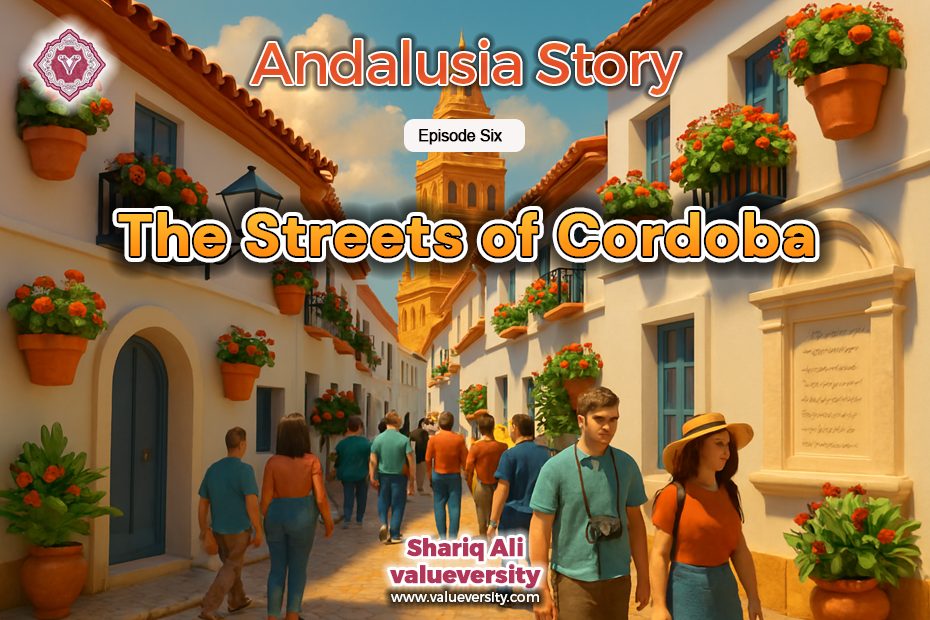The Streets of Cordoba — Episode 6 Andalusian Chronicles
Shariq Ali
Valueversity
Our group of tourists continued to move step by step through the lively streets of Cordoba. Bright sunshine bathed everything around us. The white-painted façades of most houses reflected the sunlight, making the entire scene shimmer. As we walked, glimpses of shop interiors appeared through their glass windows. The sharp aroma from fast food outlets, the sound of footsteps echoing on cobbled paths, and the array of souvenirs on sale in the small and large shops—fridge magnets, colorful fans, fragrant soaps, handmade clay pots, and much more.
In the background of this modern hustle and bustle, it felt as though the hazy shadows of the past hovered nearby.
A world unseen but deeply felt.
The very streets we were walking today had once echoed with the pen of Ibn Hayyan during the golden age of Al-Andalus. Born in 987, this historian grew up in these lanes. Through his writings, he preserved the intellectual, political, and cultural vibrancy of Cordoba.
As we walked further, some verses engraved on an ancient wall caught our eye. I thought—perhaps this was a poem by Ibn Zaydun, maybe a passionate verse written for Princess Wallada, reflecting love, rebellion, and ruin. His poetry wove all these emotions into the rich cultural tapestry of Cordoba.
During Cordoba’s golden age—when it flourished in knowledge, arts, and poetry—Ibn Zaydun was born.
He soon became famous as a handsome, intelligent, and deeply romantic poet. His verses began to echo through the royal courts.
Then his heart became attached in an extraordinary way—to Princess Wallada, daughter of the Caliph Al-Mustakfi.
But Wallada was not just a princess—she was a distinguished poetess herself. Free-spirited, bold, and determined to live life on her own terms. In that era, such a stance was remarkable.
She founded literary gatherings in Cordoba where men and women discussed literature and knowledge as equals.
This is the story of 12th-century Cordoba, where Ibn Zaydun and Wallada met—a fiery meeting of two passionate souls.
Their love was not only romantic but also intellectual and poetic. Ibn Zaydun’s verses were inspired by Wallada’s beauty and intellect, and her poetry became an echo of his emotions.
But politics, envy, and societal pressure built walls between them.
Wallada turned away from Ibn Zaydun—perhaps due to heartbreak, perhaps necessity.
He kept their love alive through his poetry for the rest of his life.
A translation of one of his famous verses goes:
“Even if you’re not with me in the darkness of night,
Still, your memory stays by my side.”
This tale of unfulfilled love still whispers through the alleyways of Cordoba.
The sunlight had shifted by now. As we continued through Cordoba’s winding, narrow, and wide streets, we reached an open square.
At its center was a small fountain, shimmering like gold in the afternoon light.
A mischievous boy was chasing pigeons away with the thump of his shoes.
Tourists were capturing moments with their cameras.
At the edge of the square, an elderly Spanish woman stood selling handmade souvenirs.
Nearby, a young man strummed an unfamiliar Andalusian tune on his guitar.
Once all the tourists gathered in a circle around our guide Pedro, he began to speak:
“During its golden age, this city made extraordinary contributions to global progress in literature, science, philosophy, and even medicine.
Do any of you know the name of one of Cordoba’s great sons?”
I gently raised my hand and said,
“Al-Zahrawi.”
Pedro smiled and replied,
“Sir, would you kindly introduce yourself and then tell us briefly about Al-Zahrawi?”
I shared my name and said that I’m a surgeon by profession.
Then I turned to my fellow tourists and began:
“Al-Zahrawi, known in the West as Abulcasis, was born in the outskirts of Cordoba in the 10th century.
At a time when most of Europe was in the Dark Ages, Muslim Spain was a beacon of enlightenment.
Al-Zahrawi transformed medicine into a full-fledged science. He wrote Al-Tasrif, a 30-volume medical encyclopedia.
The final volume was solely dedicated to surgery.
He was the first to write systematically about sterilization, surgical tools, and specific medical techniques.
You may be surprised to learn that many surgical instruments still used today—such as forceps, catheters, surgical scissors, and even fracture treatment tools—were first designed by Al-Zahrawi.
He was not just a surgeon, but a teacher. He taught his students—and generations of doctors after him—that the dignity of the patient, the intensity of their pain, and the sanctity of their life come above all else.
His contributions were not limited to Cordoba. His work continued to be taught in European medical universities for centuries.
Al-Zahrawi is undoubtedly one of the shining stars of Cordoba.”
Pedro and the other tourists listened in silence. The fountain continued to flow.
Then someone gently clapped, and others followed.
We were now entering the boundaries of Cordoba’s ancient Jewish Quarter.
…To be continued.
